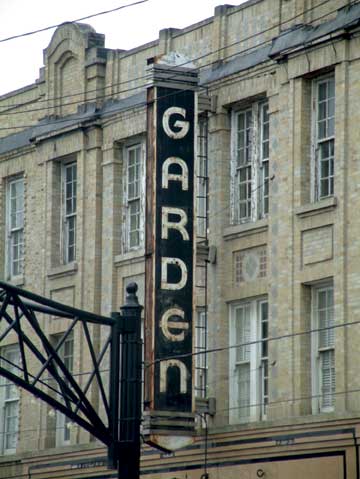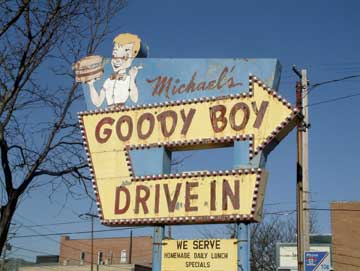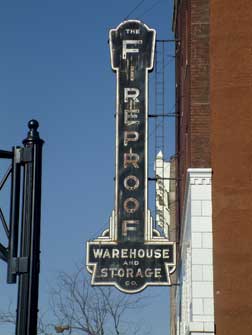
Columbus, Ohio USA
Return to Homepage www.shortnorth.com
The Short North's Vintage Street Signs
and the City That Was - and Is
Feburary 2006
by Jennifer Hambrick
jmhambrick@yahoo.com
© PHOTOS BY GUS BRUNSMAN III
In case you hadn't noticed, it's noisy on High Street these days. I'm not referring to noise from traffic or the effervescent din of conversation. It's the clangor of the present bumping into the past on the Short North's High Street strip.
The vintage street signs for many of the Short North's establishments are responsible for this hubbub, this subtle yet stimulating disturbance of the peace.
Street signs tell us things, directly and indirectly. They tell us what business occupies a certain storefront, and they give us clues about what that establishment is like. But the vintage street signs in the Short North tell us stories. Only, in some cases the endings of these stories have yet to be written.
Many of the High Street galleries, restaurants and retail stores boast new signs designed in the latest eye-catching styles. However, in looking back and looking forward at the same time, the Short North's vintage street signs epitomize the Short North itself. Some announce businesses that are as old as the signs themselves and still operating. Others are ghosts that conjure the images of once-thriving businesses now defunct. Still others call forth generations-old enterprises still in business, the nature of which has changed drastically over time. Together these signs mix the sounds of their voices whispering stories from the past with the bristling noise of the forward-looking present. Whatever stories these signs tell individually, together they tell the story of the Short North and its people.A Shadow of The Past
The area around the intersection of High Street and Fifth Avenue was not always in the state of semi-decline it's in today. Sometimes it was much better, and sometimes it was much worse.
In the 1950s and 1960s that area was the vortex of Short North social life. Wayne Washburn, a Short North resident since 1957 and owner of the now-defunct Wayne's Rod and Custom Accessories, once on the southeast corner of Fifth and High, says the intersection offered many diversions.
"In the '50s and '60s everybody went to Fifth and High Friday nights and Saturday nights," Washburn said. "You could get ice cream from Isley's (where Blazer's Pub now stands). There were always three or four bars to a block. It was just a plain, country-style atmosphere."
There was also the Garden Theatre, where you could take in a movie, and if you were hungry afterwards, you could go right next door to the Inn Town Restaurant for a meal. Although the Inn Town Restaurant is long gone, its sign remains above the shop front at 1203 North High Street as a remnant of the past. The light bulbs that once glowed within the sign are burned out, some of the sign's red writing has faded from its north side and its south side has been virtually erased by time and the elements. But even today, the sign tells us that the restaurant it represented was home to many good moments during the area's heyday.
The Inn Town wasn't the first restaurant at 1203 North High Street, nor was it the last. Its immediate predecessor was a Chinese Restaurant and before that, it was home to the American Restaurant. Washburn said the American Restaurant was a hamburger joint that closed sometime in the 1960s when the Inn Town came in. Washburn remembers the food at the Inn Town was basic American grub.
"They served just the regular French fries, hamburgers, some dinners – meatloaf, liver and onions," Washburn said. "Just the basic type of fare."
At the Inn Town you could get a dinner for less than three dollars, and a dollar and change would buy you a burger and fries.
The ambience was equally unassuming. There was no lunch counter at the Inn Town, only a selection of booths and tables worked by a staff of waitresses and busboys.
Washburn's sister-in-law was a waitress at the Inn Town for years and Washburn himself was something of a regular at the restaurant. Through his sister-in-law he got to know the restaurant's owners (who later owned Roadhouse Annie's at Price and High) and also a little bit of the restaurant itself behind the scenes.
"They peeled the potatoes in the basement," Washburn said. "I remember seeing that big potato peeler in the basement."
When the Inn Town closed in the late 1980s or early 1990s, the Presto Bar moved in from the northeast corner of Fifth and High, taking its own cast of characters with it. Washburn recalls one of the waitresses at the Presto.
"There was a barmaid at the Presto named Rosie," Washburn said. "I went into the marines (in 1960) and came out in the early '70s and the Presto had moved across the street and Rosie was still working there."
A Presto Bar regular named Harry Parrott, still a Short North resident, also made the shift across the intersection when the Presto Bar replaced the Inn Town.
By the time the Inn Town closed, the area around Fifth and High was already well in decline. Prostitutes and drug dealers worked the streets and had moved into the apartments above the Garden Theater.
But while the neighborhood fell into disrepair, the sign for the Inn Town Restaurant stood firm – and is likely to do so for a while. According to James Goodman, assistant historic preservation officer with the City of Columbus, for at least the last 25 years the Victorian Village commission has not permitted new signs with interior lighting to be put up in front of businesses on High Street in the Short North. However, a sign with interior illumination that pre-dates the Commission's ban is grandfathered in and may remain in place. Dr. Robert Banasik, owner of the former Inn Town Restaurant property, says he'll leave the sign up in case a future tenant of the property wants to use it.
"I'm interested in keeping it so that someone who might want that amenity could use it," Banasik said.
Whatever may happen to it in the future, the old Inn Town Restaurant sign is for now a reminder of happier days at Fifth and High.A Garden of Renewal
On the afternoon of Thanksgiving Day 1920, the Garden Theatre opened at 1187 North High Street amidst great celebration. Cellist Ferdinand Gardiner played at that day's festive matinee and again with the rest of his piano trio at a gala evening showing. The Garden Theatre was actually both of these things: it was a state-of-the-art movie house with a single screen for showing silent films (and later "talkies"), and it had a sunken garden enclosed with a fragrant boxwood hedge where an orchestra pit would normally have been.
This exotic touch – along with the theater's resplendent pale blue and copper-colored accents and the delicious breezes of what is reputed to be one of the first air-conditioning systems installed in a public theater – must have given the place the feel of Shangri-la. Its sunken garden might also be why some maps of Columbus from the early part of the twentieth century label the current Short North area as the Garden District. And if there were any doubt that the Garden Theatre was the defining landmark of the area, the large, distinctive Garden Theatre sign that went up outside the building in the 1930s certainly erased it.
Time passed, and within two generations of the theater's opening it went from the lap of luxury to the seat of crime. The theater that had shown Westerns and lavish Hollywood musicals in the 1950s became a forum for the viewing and making of pornographic films in the 1970s and 1980s. The university professors and business people who once lived in the apartments that lined the building's High Street side were replaced by prostitutes and drug dealers. The building's facade and interior structure fell dangerously into disrepair.
This downward spiral continued until 1996, when Steve Campbell took over the property. What once housed the Garden Theater is now home to the Garden Church and its ministries for urban youth. And like Phoenix rising from the ashes, the Garden at Fifth and High seems to be coming into bloom again.
Garden Church head pastor Campbell is a man with a past and a passion. A native of southern Kansas, Campbell's acquaintance with street culture in his youth led him to a teen drug center in Philadelphia, where he wound up while on the run from criminals who were out to kill him, and where Campbell says he became a Christian. He made his way back to Kansas, and then Colorado, and had a successful business career in leather and horse goods.
A job transfer to Ohio launched Campbell's career in ministry. Campbell met Pastor Bob Swanger, the founding pastor of Christ the King Lutheran Church, now Polaris Church, when the two played each other in the finals of a Columbus tennis tournament. He assisted Swanger with his ministry and eventually started his own.
Something of a child of the streets, Campbell has made a life of reaching out to urban people, especially urban youth.
In addition to the non-denominational Christian worship service the Garden Church holds every Sunday, the church operates an outreach ministry for urban children aged four through 11. It also runs a teen ministry program, Urban Revolution (U-Rev), which brings at-risk teens from all over the greater Columbus area to the church for fellowship and educational events.
"The Short North is my home, and I feel the people of the street are my family," Campbell said.
But Campbell says it took a while for things to feel that way. At first, he went door-to-door in some of the Short North's poorest neighborhoods, talking to teens, asking them to come see what the Garden Church had to offer them. Now that the word is out about U-Rev, there is a waiting list for the program.
As Campbell has worked to renovate the souls of the youth who come through his programs, he also has worked to restore the old Garden Theatre building to usable condition. The former theater lobby has been given new paint and carpeting. The balcony is now a game room and home to two foosball tables. The old projection room now houses a circuit of free weights. The apartments, which Campbell says had devolved into filth and decay, have been cleaned and refurbished as tutoring rooms; bright, airy nurseries; colorful children's playrooms; and polished, professional-looking offices. He sees all of this as part of his church's plan of renewal and hope.
"What we do with this building is an example of what God does with our lives, how He takes our burned-out, gutted lives that we've made a mess of and renovates them," Campbell said.
Although the actual theater auditorium remains to be refurbished, Campbell has plans to renovate it when funds are available. And he hopes someday either to restore the vintage sign outside the theater or to replace it with a replica.
"We feel this sign is something of a landmark here," Campbell said. "If I have to replace it, I'd like to do an exact duplicate."
Even if the building is no longer used as a movie theater, the Garden Theatre's opening might well have prefigured Campbell's ministry at the Garden Church. Those celebratory first showings in the Garden Theatre on Thanksgiving Day 1920 featured noted actor Lewis Sargent in a silent film called The Soul of Youth.
The Actually Old and the Retro
For John Trokas, owning Michael's Goody Boy (1144 N. High Street) is just family business as usual. Trokas is the third owner of Michael's Goody Boy, which opened in 1947 under the ownership of Trokas' great-uncle Mike Pappas. Pappas sold the restaurant in 1977 to his nephew George Stabodokiss. Trokas bought the property from Stabodokiss, his uncle, in 1999.
Both the sign outside the restaurant and the fixtures inside date from 1947, Trokas said. The sign's distinctive giant arrow, which loops angularly to point back toward the restaurant and glows with the light of hundreds of flashing light bulbs, is the centerpiece of a typical 1950s diner sign.
But the sign is showing its age. Trokas says he has plans to renovate it in four or five months. The work will mainly involve replacing old lights and updating the paint, anything to bring the sign back to its original glory.
"We are planning to replace the sign to make everything like it was 50 years ago," Trokas said.
As striking as Michael's vintage street sign is, the juxtaposition of it with the sign for Skully's Music-Diner (1151 North High Street) almost directly across High Street is even more so. Erected in 2002, the Skully's sign was designed in 1950s retro style and features many of the same elements that appear in the Michael's Goody Boy sign. Skully's borrowed the looping arrow with flashing lights from the 1950s idiom, but the arrow is updated to be curved, not angular, and the clear blinking light bulbs of the Michael's Goody Boy sign are replaced with brilliant red neon stripes.
Skully's owner Skully Webb, who helped design the sign for his music-diner, says the design was not an imitation of the Michael's Goody Boy sign.
"Michael's didn't influence me. This idea was in my head before I even moved to that location," Webb said. "That was a common theme in the '50s, a big flashing arrow. Drive-ins and movie theaters were all the rage and I got ideas from that."
Webb says the Skully's sign speaks to people and draws in customers.
"When we designed it, we knew we wanted something that would last for many years and be kind of the landscape for the Short North," Webb said. "It pays for itself every day. People come in off the street because that marquee makes them feel good. They say they wanted to see what this place was about because the marquee drew them in."
Far from feeling competitive, Trokas likes the Skully's sign and says it brings in business for him, too.
"It's a good sign. It's a very attractive sign," Trokas said. "Skully's helps my business – when people go there, they come across the street and eat."
New Wine in an Old Bottle
The sign that reads "Fireproof Warehouse and Storage Co.," in front of the building at 1024 North High Street, is an old sign for an old company that now does new things.
In 1906, the Murrin family started a moving and storage company in Columbus, operating a fleet of horse-drawn wagons for moving the belongings of wealthy Columbusites into storage facilities for the summer or onto railroad cars for permanent moves.
Three years later, most of the building that still houses the Fireproof company had been constructed, and the company has been in business continually for nearly a century.
However, even though Fireproof is still in business, the full name of the company, and the nature of the company's business, have changed. Since the 1970s Fireproof has worked in business records storage and still offers on-site, brick-and-mortar storage in their warehouses and high-tech storage of business records and documents in "virtual" storage space.
The new nature of the business Fireproof does has prompted its owners and officers to re-christen the High Street building the Fireproof Records Center. But the sign outside the building still says "Fireproof Warehouse and Storage Co." Fireproof chief executive officer Mike James says the historic sign poses a dilemma for his company.
"It's not what we do anymore, so (the sign is) kind of confusing to people," James said. "We've talked about tearing it down, updating it. Our business is kind of an unmarked business to some extent, but it's been such a landmark that people recognize it. A lot of times you'll go talk to somebody who's 25 years old – anybody who's been in the Short North area – recognizes the sign."
James said that updating the Fireproof sign might be on the horizon for 2006, the company's centennial year.
"It (changing or updating the sign) is probably on our radar for next year. We've talked about doing something with the lighting of it and we've talked about re-doing the neon and for our anniversary having the sign back up and running. That'd be kind of neat."
In the meantime, the Fireproof Records Center will make do with its historic Fireproof Warehouse and Storage Co. sign and the story it tells of Columbus in horse-and-wagon days. And the Short North's other vintage street signs will continue to tell their tales of the past as the district moves ahead into the future.©2006 Short North Gazette, Columbus, Ohio. All rights reserved.


